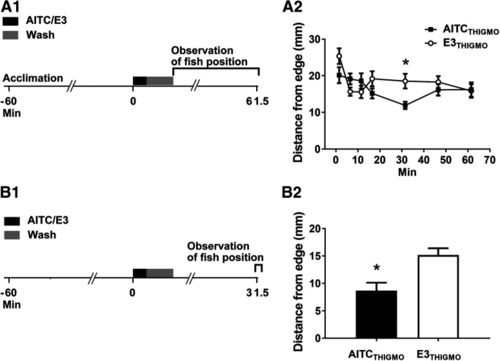
Thigmotaxis is enhanced by AITC in larval zebrafish. A1, Experimental protocol. The larvae, 20 at a time, were placed into a Petri dish and allowed to acclimate to the dish for 60 min, after which they were exposed to AITC/E3 for 30 s. Following 1 min of washout of the AITC/E3, the larvae were transferred to a larger Petri dish and their positions measured over time. A2, Postexposure effect of AITC on thigmotaxis. A repeated-measures, two-way ANOVA (F(6,108) = 3.30; p = 0.01) found an interaction between exposure to AITC/E3 and the time of test. Probes of this interaction using one-way ANOVAs indicated that only for 31.5-min test was there a significant difference between the AITCTHIGMO (n = 10) and E3THIGMO (n = 10) fish (F(1,18) = 8.91, p = 0.008). B1, Experimental protocol for planned 31.5-min test of AITC-induced increase in thigmotaxis. B2, Effect of AITC/E3 on thigmotaxis at 31.5 min posttreatment. Following exposure to AITC, fish (AITCTHIGMO group, n = 8) were significantly closer to the edge of the dish than were fish after exposure to E3 alone (E3THIGMO group, n = 8; t(14) = 3.40, p = 0.004). This figure shows means ± SEM; * indicates a significant (p < 0.05) difference between groups.
|

